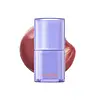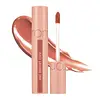What's inside
What's inside
 Key Ingredients
Key Ingredients

 Benefits
Benefits

 Concerns
Concerns

 Ingredients Side-by-side
Ingredients Side-by-side

Water
Skin ConditioningDiglycerin
HumectantDiphenyl Dimethicone
EmollientPhytosteryl/Isostearyl/Cetyl/Stearyl/Behenyl Dimer Dilinoleate
Skin ConditioningCetyl PEG/PPG-10/1 Dimethicone
EmulsifyingPhenyl Trimethicone
Skin ConditioningPolyglyceryl-10 Decaisostearate
EmollientPolyphenylsilsesquioxane
Bis-Diglyceryl Polyacyladipate-2
EmollientHydrogenated Polycyclopentadiene
Trimethylsiloxysilicate
EmollientPolysorbate 60
EmulsifyingPentylene Glycol
Skin ConditioningIsododecane
EmollientOctyldodecanol
EmollientSorbitan Isostearate
EmulsifyingOpuntia Coccinellifera Fruit Extract
Skin ConditioningSodium Hyaluronate
HumectantHydrolyzed Hyaluronic Acid
HumectantHyaluronic Acid
HumectantPolyglyceryl-4 Isostearate
EmulsifyingHydroxyethyl Acrylate/Sodium Acryloyldimethyl Taurate Copolymer
Emulsion StabilisingSqualane
EmollientCeteareth-20
CleansingPEG-11 Methyl Ether Dimethicone
EmulsifyingDiisostearyl Malate
EmollientPolyacrylate-13
Dipropylene Glycol
HumectantPolyisobutene
Ethylhexylglycerin
Skin ConditioningPanthenol
Skin ConditioningTrisodium Ethylenediamine Disuccinate
Hydrogenated Lecithin
EmulsifyingPolysorbate 20
EmulsifyingPentaerythrityl Tetra-Di-T-Butyl Hydroxyhydrocinnamate
AntioxidantButylene Glycol
HumectantPropanediol
Solvent1,2-Hexanediol
Skin ConditioningBenzyl Glycol
SolventCaprylyl/Capryl Glucoside
CleansingHydrolyzed Glycosaminoglycans
HumectantHydroxypropyltrimonium Hyaluronate
Sodium Hyaluronate Crosspolymer
HumectantSodium Acetylated Hyaluronate
HumectantCeramide NP
Skin ConditioningHydrolyzed Sodium Hyaluronate
Skin ConditioningPotassium Hyaluronate
Skin ConditioningPhenoxyethanol
PreservativeParfum
MaskingHexyl Cinnamal
PerfumingLinalool
PerfumingAlpha-Isomethyl Ionone
PerfumingBenzyl Salicylate
PerfumingCI 77891
Cosmetic ColorantCI 77492
Cosmetic ColorantCI 77491
Cosmetic ColorantCI 77499
Cosmetic ColorantCI 15850
Cosmetic ColorantCI 17200
Cosmetic ColorantCI 19140
Cosmetic ColorantCI 15985
Cosmetic ColorantCI 42090
Cosmetic ColorantWater, Diglycerin, Diphenyl Dimethicone, Phytosteryl/Isostearyl/Cetyl/Stearyl/Behenyl Dimer Dilinoleate, Cetyl PEG/PPG-10/1 Dimethicone, Phenyl Trimethicone, Polyglyceryl-10 Decaisostearate, Polyphenylsilsesquioxane, Bis-Diglyceryl Polyacyladipate-2, Hydrogenated Polycyclopentadiene, Trimethylsiloxysilicate, Polysorbate 60, Pentylene Glycol, Isododecane, Octyldodecanol, Sorbitan Isostearate, Opuntia Coccinellifera Fruit Extract, Sodium Hyaluronate, Hydrolyzed Hyaluronic Acid, Hyaluronic Acid, Polyglyceryl-4 Isostearate, Hydroxyethyl Acrylate/Sodium Acryloyldimethyl Taurate Copolymer, Squalane, Ceteareth-20, PEG-11 Methyl Ether Dimethicone, Diisostearyl Malate, Polyacrylate-13, Dipropylene Glycol, Polyisobutene, Ethylhexylglycerin, Panthenol, Trisodium Ethylenediamine Disuccinate, Hydrogenated Lecithin, Polysorbate 20, Pentaerythrityl Tetra-Di-T-Butyl Hydroxyhydrocinnamate, Butylene Glycol, Propanediol, 1,2-Hexanediol, Benzyl Glycol, Caprylyl/Capryl Glucoside, Hydrolyzed Glycosaminoglycans, Hydroxypropyltrimonium Hyaluronate, Sodium Hyaluronate Crosspolymer, Sodium Acetylated Hyaluronate, Ceramide NP, Hydrolyzed Sodium Hyaluronate, Potassium Hyaluronate, Phenoxyethanol, Parfum, Hexyl Cinnamal, Linalool, Alpha-Isomethyl Ionone, Benzyl Salicylate, CI 77891, CI 77492, CI 77491, CI 77499, CI 15850, CI 17200, CI 19140, CI 15985, CI 42090
Water
Skin ConditioningOctyldodecanol
EmollientDimethicone
EmollientAlcohol Denat.
AntimicrobialAcrylates Copolymer
Polysorbate 60
EmulsifyingEthylcellulose
Behenyl Alcohol
EmollientPentylene Glycol
Skin ConditioningSodium Acrylate/Sodium Acryloyldimethyl Taurate Copolymer
Emulsion StabilisingSilica
AbrasiveSorbitan Stearate
EmulsifyingIsohexadecane
EmollientDiisostearyl Malate
EmollientPhenoxyethanol
PreservativeCI 77891
Cosmetic ColorantPolyglyceryl-2 Triisostearate
EmulsifyingPolysorbate 80
EmulsifyingCI 77491
Cosmetic ColorantCI 77492
Cosmetic ColorantParfum
MaskingCI 77499
Cosmetic ColorantSorbitan Oleate
EmulsifyingAroma
Trisodium Ethylenediamine Disuccinate
Ethylhexylglycerin
Skin ConditioningCI 15850
Cosmetic ColorantPolyglyceryl-2 Diisostearate
EmulsifyingCI 17200
Cosmetic ColorantCI 15985
Cosmetic ColorantCI 42090
Cosmetic ColorantButylene Glycol
HumectantActinidia Chinensis Fruit Extract
EmollientCarica Papaya Fruit Extract
Skin ConditioningCitrus Paradisi Fruit Extract
Skin ConditioningCocos Nucifera Fruit Extract
EmollientMangifera Indica Fruit Extract
Skin ConditioningPsidium Guajava Fruit Extract
AstringentWater, Octyldodecanol, Dimethicone, Alcohol Denat., Acrylates Copolymer, Polysorbate 60, Ethylcellulose, Behenyl Alcohol, Pentylene Glycol, Sodium Acrylate/Sodium Acryloyldimethyl Taurate Copolymer, Silica, Sorbitan Stearate, Isohexadecane, Diisostearyl Malate, Phenoxyethanol, CI 77891, Polyglyceryl-2 Triisostearate, Polysorbate 80, CI 77491, CI 77492, Parfum, CI 77499, Sorbitan Oleate, Aroma, Trisodium Ethylenediamine Disuccinate, Ethylhexylglycerin, CI 15850, Polyglyceryl-2 Diisostearate, CI 17200, CI 15985, CI 42090, Butylene Glycol, Actinidia Chinensis Fruit Extract, Carica Papaya Fruit Extract, Citrus Paradisi Fruit Extract, Cocos Nucifera Fruit Extract, Mangifera Indica Fruit Extract, Psidium Guajava Fruit Extract
 Reviews
Reviews

Ingredients Explained
These ingredients are found in both products.
Ingredients higher up in an ingredient list are typically present in a larger amount.
Butylene Glycol (or BG) is used within cosmetic products for a few different reasons:
Overall, Butylene Glycol is a safe and well-rounded ingredient that works well with other ingredients.
Though this ingredient works well with most skin types, some people with sensitive skin may experience a reaction such as allergic rashes, closed comedones, or itchiness.
Learn more about Butylene GlycolCi 15850 is the pigment color red. It is an azo dye and created synthetically.
Azo dyes need to be thoroughly purified before use. This allows them to be more stable and longer-lasting.
This ingredient is common in foundations, lipsticks, and blushes. This color is described as brown/orangey red.
It has many secondary names such as Red 6 and Red 7. According to a manufacturer, Red 6 usually contains aluminum.
Learn more about CI 15850Ci 15985 is a dye made from petroleum. It is synthetically created and approved by the FDA for use in foods and cosmetics.
The color of this dye is orange/yellow.
This ingredient can be found in makeup, sun care, and skincare.
Learn more about CI 15985Ci 17200 is a synthetic reddish-purple dye.
Ci 42090 is a synthetic dye created from petroleum. It is used to give a bright blue color to cosmetics, medicine, and food.
Ci 77491 is also hydrated iron III oxide. It's sole purpose is to give a red/pink hue to products.
Iron III oxides are classified as inorganic chemicals for coloring.
Synthetically created Ci 77491 is considered safer than those naturally found. This is because the synthetically created version may contain less impurities. Iron oxides are generally non-toxic and non-allergenic.
Learn more about CI 77491Ci 77492 is also hydrated iron III oxide. It's sole purpose is to give a yellow hue to products.
Iron III oxides are classified as inorganic chemicals for coloring.
Synthetically created Ci 77492 is considered safer than those naturally found. This is because the synthetically created version may contain less impurities. Iron oxides are generally non-toxic and non-allergenic.
Learn more about CI 77492Ci 77499 is also hydrated iron III oxide. It is created from mixing red and black iron oxides. This helps give shades of darkness to a product.
Iron III oxides are classified as inorganic chemicals for coloring.
Ci 77891 is a white pigment from Titanium dioxide. It is naturally found in minerals such as rutile and ilmenite.
It's main function is to add a white color to cosmetics. It can also be mixed with other colors to create different shades.
Ci 77891 is commonly found in sunscreens due to its ability to block UV rays.
Learn more about CI 77891Diisostearyl Malate is an emollient and most often used in lip products. It comes from isostearyl alcohol, a fatty acid, and malic acid, an AHA.
As an emollient, Diisostearyl Malate helps create a thin film on your skin to trap moisture in. This helps keep your skin soft and smooth.
Ethylhexylglycerin (we can't pronounce this either) is commonly used as a preservative and skin softener. It is derived from glyceryl.
You might see Ethylhexylglycerin often paired with other preservatives such as phenoxyethanol. Ethylhexylglycerin has been found to increase the effectiveness of these other preservatives.
Octyldodecanol is a fatty alcohol. It is primarily used to enhance the texture of products.
As an emulsifier, Octyldodecanol helps prevent the oils and waters from separating. It also prevents ingredients from creating foam when shaken.
Octyldodecanol is created by reducing fatty acid to an alcohol.
Due to its high molecular weight, it does not get absorbed into the skin.
Learn more about OctyldodecanolParfum is a catch-all term for an ingredient or more that is used to give a scent to products.
Also called "fragrance", this ingredient can be a blend of hundreds of chemicals or plant oils. This means every product with "fragrance" or "parfum" in the ingredients list is a different mixture.
For instance, Habanolide is a proprietary trade name for a specific aroma chemical. When used as a fragrance ingredient in cosmetics, most aroma chemicals fall under the broad labeling category of “FRAGRANCE” or “PARFUM” according to EU and US regulations.
The term 'parfum' or 'fragrance' is not regulated in many countries. In many cases, it is up to the brand to define this term.
For instance, many brands choose to label themselves as "fragrance-free" because they are not using synthetic fragrances. However, their products may still contain ingredients such as essential oils that are considered a fragrance by INCI standards.
One example is Calendula flower extract. Calendula is an essential oil that still imparts a scent or 'fragrance'.
Depending on the blend, the ingredients in the mixture can cause allergies and sensitivities on the skin. Some ingredients that are known EU allergens include linalool and citronellol.
Parfum can also be used to mask or cover an unpleasant scent.
The bottom line is: not all fragrances/parfum/ingredients are created equally. If you are worried about fragrances, we recommend taking a closer look at an ingredient. And of course, we always recommend speaking with a professional.
Learn more about ParfumPentylene glycol is typically used within a product to thicken it. It also adds a smooth, soft, and moisturizing feel to the product. It is naturally found in plants such as sugar beets.
The hydrophilic trait of Pentylene Glycol makes it a humectant. As a humectant, Pentylene Glycol helps draw moisture from the air to your skin. This can help keep your skin hydrated.
This property also makes Pentylene Glycol a great texture enhancer. It can also help thicken or stabilize a product.
Pentylene Glycol also acts as a mild preservative and helps to keep a product microbe-free.
Some people may experience mild eye and skin irritation from Pentylene Glycol. We always recommend speaking with a professional about using this ingredient in your routine.
Pentylene Glycol has a low molecular weight and is part of the 1,2-glycol family.
Learn more about Pentylene GlycolPhenoxyethanol is a preservative that has germicide, antimicrobial, and aromatic properties. Studies show that phenoxyethanol can prevent microbial growth. By itself, it has a scent that is similar to that of a rose.
It's often used in formulations along with Caprylyl Glycol to preserve the shelf life of products.
Polysorbate 60 is used to help stabilize products. It is a surfactant and emulsifier. These properties help keep ingredients together in a product. Surfactants help reduce surface tension between ingredients with different states, such as liquids and solids. Emulsifiers help prevent oils and waters from separating.
Polysorbate 60 is sorbitol-based and created from the ethoxylation of sorbitan. Ethoxylation is a chemical reaction used to add ethylene oxide. Sorbitan is a the dehydrated version of sorbitol, a sugar found in fruits.
In this case, the 60 comes from reacting 60 units of ethylene oxide with sorbitan.
Polysorbates are commonly used in medicine and foods.
Learn more about Polysorbate 60Trisodium Ethylenediamine Disuccinate is used to help stabilize a product.
It is a chelating agent, meaning it helps prevent metal ions from binding to other ingredients. This prevents unwanted reactions in products. Metal ions can come into a product via the water ingredient. They are found in trace amounts and are not known to be harmful.
Water. It's the most common cosmetic ingredient of all. You'll usually see it at the top of ingredient lists, meaning that it makes up the largest part of the product.
So why is it so popular? Water most often acts as a solvent - this means that it helps dissolve other ingredients into the formulation.
You'll also recognize water as that liquid we all need to stay alive. If you see this, drink a glass of water. Stay hydrated!
Learn more about Water